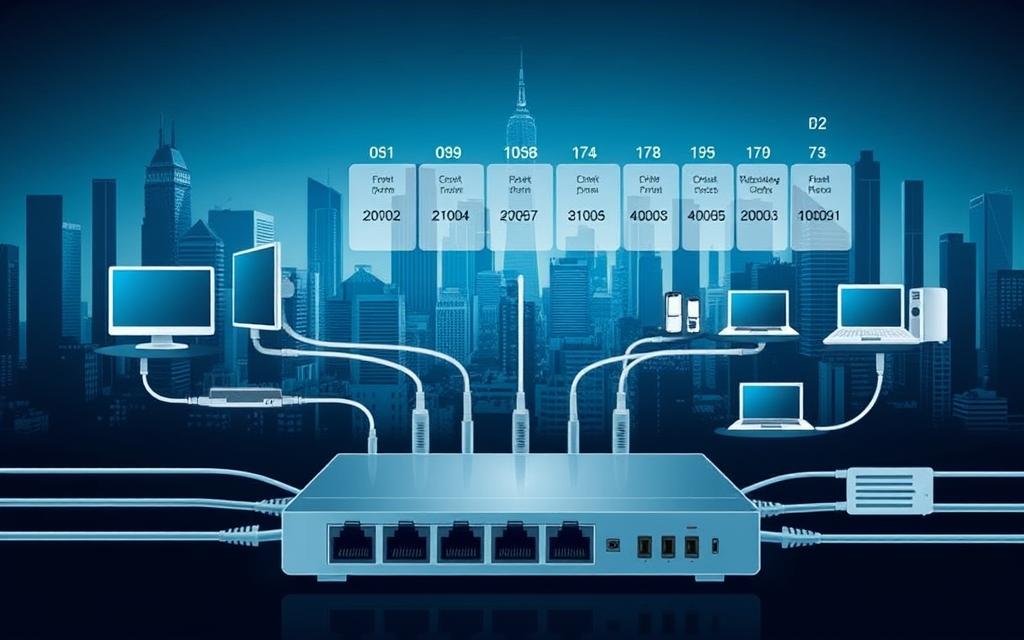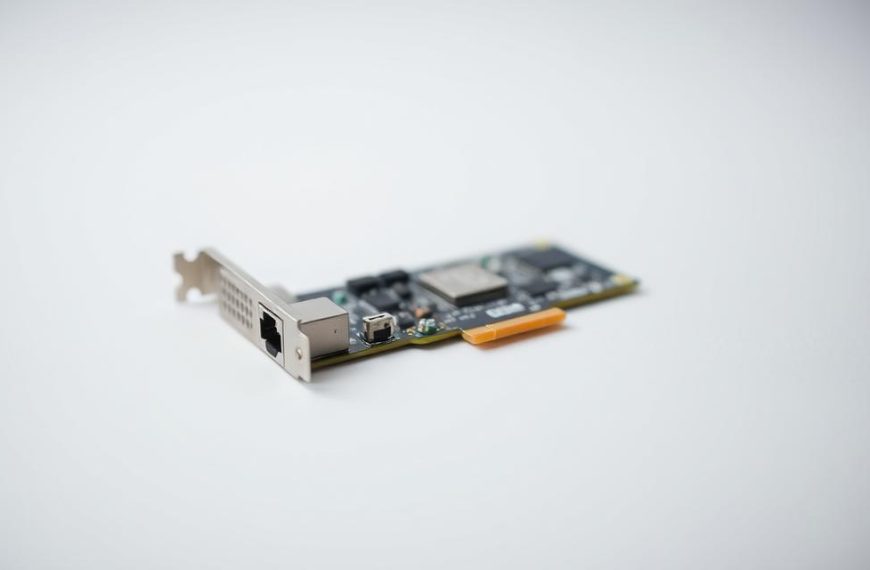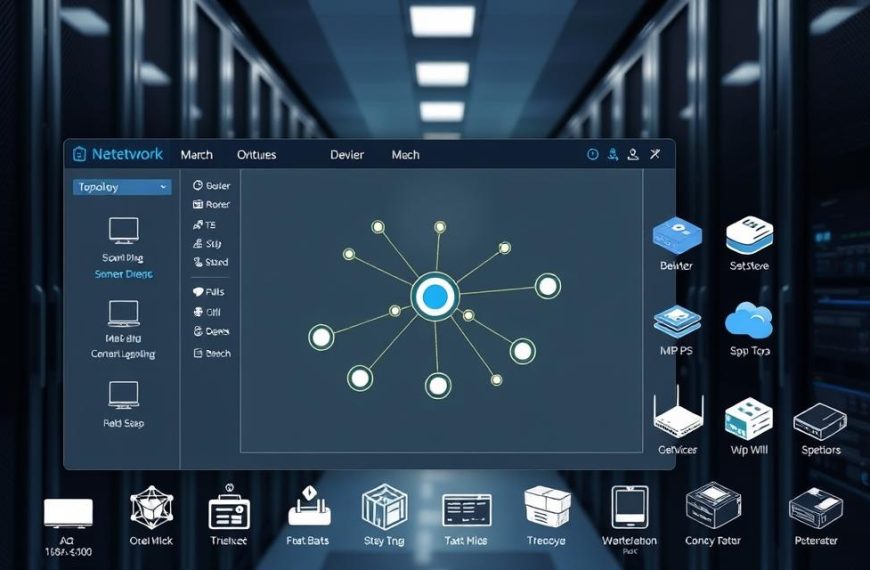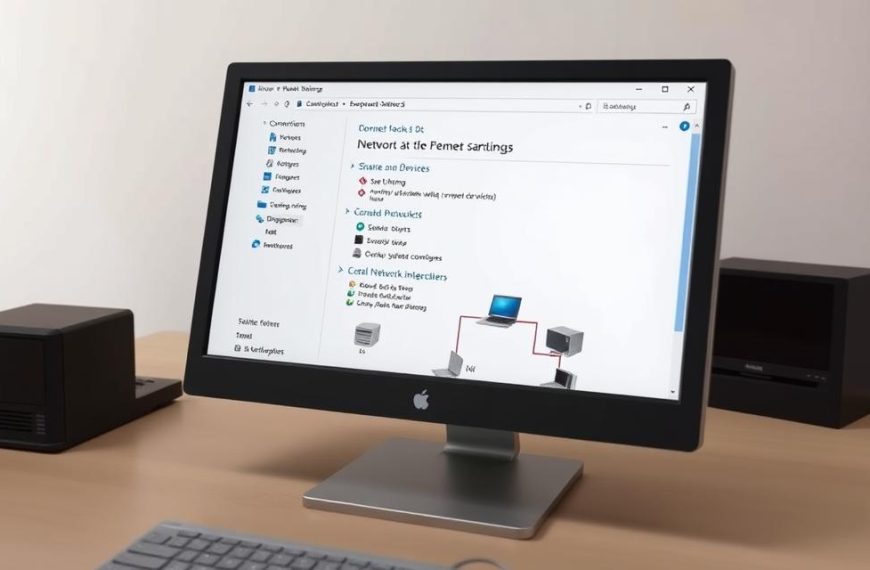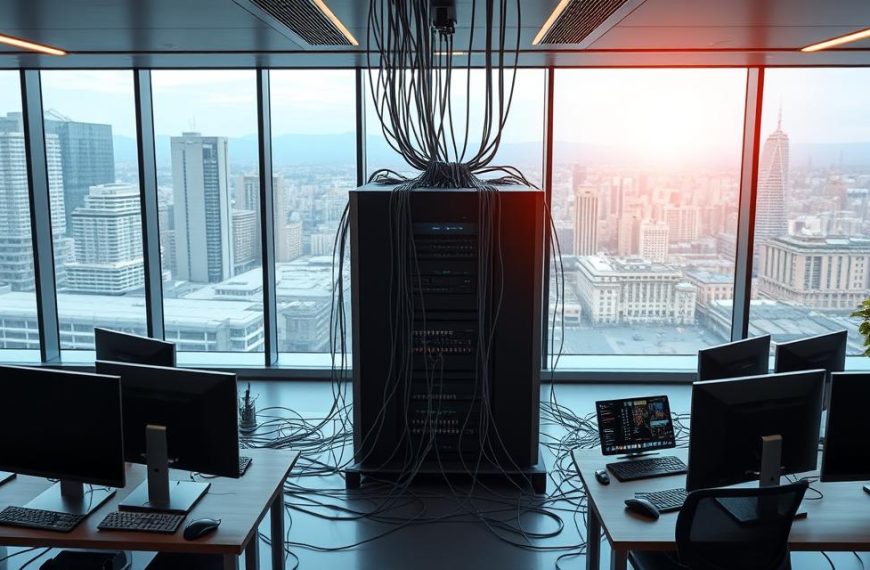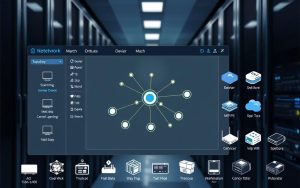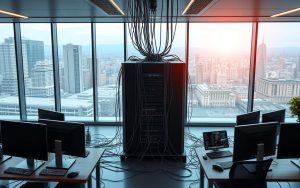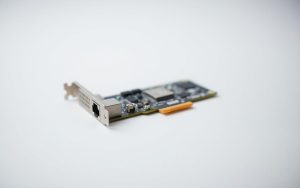Think of your computer as a busy office building. It gets lots of deliveries every day. Each package must go to the right department to be handled properly.
In data communication, digital info moves in packets across networks. These packets need the right address to reach their destination apps.
The system for addressing packets uses network protocols. It was first used in ARPANET to manage early internet traffic.
A unique identifier guides each packet to its correct service. This smart system makes sure info flows smoothly between devices.
Grasping this key concept is vital for understanding computer networking basics. It’s the foundation of today’s digital connections.
Understanding the Fundamentals of Port Numbers
IP addresses are like digital street addresses. Port numbers are the final step in sending data. They help make sure data gets to the right app on your device.
Defining Port Numbers in Network Communications
Port numbers are 16-bit integers from 0 to 65535. They are like communication endpoints for apps and services on devices.
When data moves through networks, port numbers guide it to the right software. Without them, your computer would mix up different types of data.
The Relationship Between IP Addresses and Port Numbers
IP addresses and port numbers are key to modern networks. An IP address finds the device, and a port number finds the app.
How IP Addresses and Ports Work Together
In TCP/IP, each data packet has an IP address and a port number. This lets data find its way to the right app.
Devices use this info to handle many connections at once. Your computer can download files and browse the web at the same time.
Analogy: Buildings, Flats, and Room Numbers
Think of the internet as a huge city. Each building is a device with its own IP address. Inside, flats are different apps or services.
Port numbers are like flat numbers. Just as you need a building and flat number for mail, networks need IP and port numbers for data.
This way, web traffic (port 80) gets to your browser, and email (port 25) reaches your email client. Both use the same IP address.
What is a Port Number in Computer Network: Technical Specifications
Port numbers are part of a detailed system that controls network communications. They are key to how data moves around the world’s networks.
The Structure and Range of Port Numbers
Port numbers use a 16-bit system, which means there are 65,536 possible values. They range from 0 to 65535, each one a unique address.
The Internet Assigned Numbers Authority, or IANA, manages these port numbers. They make sure the system works the same everywhere.
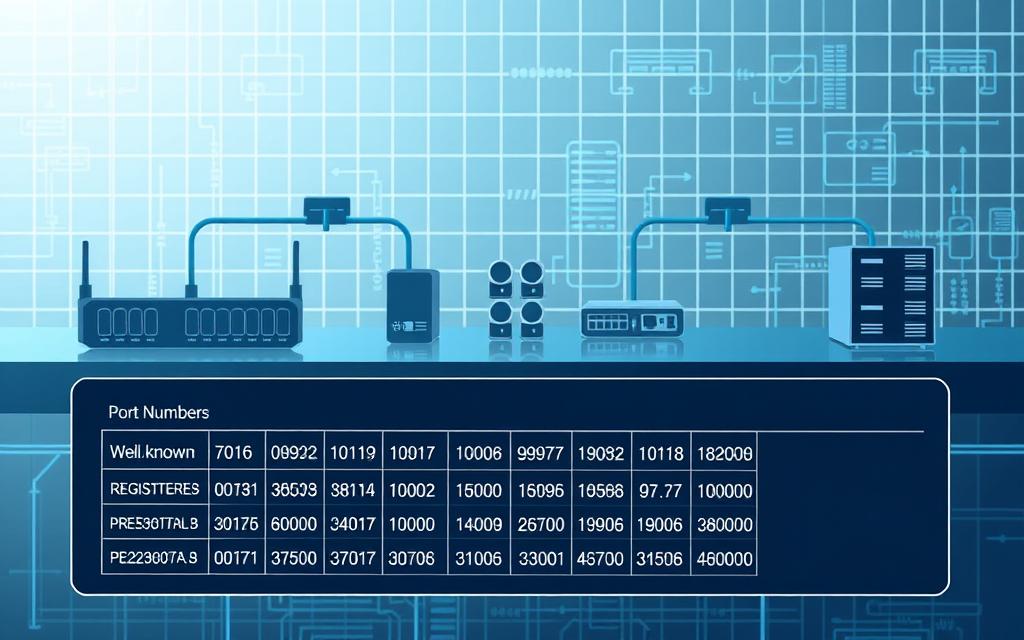
Well-known ports are from 0 to 1023. These are for basic internet services and system processes.
For example, port 80 is for HTTP web traffic, and port 21 for FTP file transfers. It’s important for admins to check the official list for these ports.
Registered Ports (1024-49151)
Registered ports are from 1024 to 49151. These are for specific software applications. Companies get these ports from IANA for their own programs.
These ports are not for system services. They are for user apps and special network services.
Dynamic/Private Ports (49152-65535)
Dynamic or private ports are from 49152 to 65535. These are for short-term connections and client-side talks.
Systems usually pick these ports randomly for outgoing connections. They are called ephemeral ports because they are short-lived.
How Port Numbers are Assigned and Managed
IANA controls port number allocation. They check applications and keep official lists.
For well-known ports, IANA has strict rules. They also manage the database for commercial use.
Network admins need to know how ports are assigned. This helps keep networks running smoothly and avoids problems.
Common Port Numbers and Their Applications
Network communication uses standardised port numbers to direct traffic. Knowing these ports is key for setting up networks, keeping them secure, and solving problems.
Essential Well-Known Ports Every Network Professional Should Know
Well-known ports are from 0 to 1023 and are vital for the internet. They help ensure smooth communication worldwide.
Port 80: HTTP Web Traffic
The HTTP port handles web page requests and responses. It’s an open channel that’s good for basic browsing but not secure.
Many sites used port 80 before security became a big deal. Now, they often move to safer ports.
Port 443: HTTPS Secure Web Traffic
This HTTPS port uses SSL/TLS for encrypted communication. It’s the go-to for secure web transactions and data sharing.
Online shops, banks, and any site handling sensitive info use this port. It keeps data safe from hackers.
Port 25: SMTP Email
The SMTP port is for sending emails between servers. It’s key for sending emails over the internet.
Port 25 is vital but needs careful security. ISPs often limit it to stop spam.
Important Registered Ports for Various Services
Registered ports (1024-49151) are for specific uses and can be customised. They support many services, from file sharing to remote access.
- Ports 20/21: FTP ports manage file transfers between systems
- Port 22: SSH offers secure remote access
- Port 53: DNS translates domain names to IP addresses
- Port 110: POP3 gets emails from servers to clients
- Port 143: IMAP manages emails on remote servers
- Port 3389: RDP allows graphical remote desktop access
Services like Gmail use secure versions of these ports. IMAP often uses port 993 with SSL for better security.
Database systems often use registered ports for connections. MySQL is on port 3306, and PostgreSQL is on port 5432.
How Port Numbers Facilitate Data Transfer
Port numbers are key to organised data exchange across networks. They act as addresses, ensuring data reaches the right application. This makes modern networking efficient.

The Role of Ports in TCP/IP Protocol Suite
In the TCP/IP protocol suite, port numbers are at the transport layer. They are vital for communication sessions. They help ensure data goes to the correct application, even if a device has many services.
This setup allows data multiplexing. It means many streams can use the same network connection without problems. Port numbers help sort these streams, sending each packet to its right application.
TCP and UDP protocols use ports differently. TCP ports create reliable sessions with error checks and retransmissions. UDP ports are for fast, connectionless data, great for live streams.
Port Number Allocation During Communication Sessions
Every network session needs port number coordination between client and server. This ensures data exchange is smooth and sessions are isolated.
Client-Side Port Allocation
When a client starts communication, it picks an ephemeral port from 49152-65535. This port is for the server’s response. It lets the client connect to many services at once.
The client’s transport layer puts both the destination and source ports in each packet. This makes sure responses get back to the right application.
Server-Side Port Listening
Server apps listen on specific ports for incoming requests. They use the transport layer to watch these ports and forward packets to the right service.
For example, a web server listens on port 80 for HTTP or 443 for HTTPS. When a request comes in, the server’s transport layer sends it to the right web server software.
This port-based system is key for client-server communication. It supports the network services we use every day. It also manages many connections at once through data multiplexing.
Port Number Security Considerations
Managing network security ports is key to keeping networks safe. Open ports let in good traffic but also bad. This makes them a risk.
Common Security Risks Associated with Open Ports
Open ports are a big risk for any network. They can let in unwanted access and threats.
The main open port risks are:
- Unauthorised remote access to sensitive systems
- Potential for service exploitation and privilege escalation
- Increased attack surface for distributed denial-of-service attempts
- Data exfiltration opportunities for malicious actors
Best Practices for Port Management and Security
Good port management lowers risks and keeps communication flowing.
Port Scanning and Detection Methods
Regular port scanning is a must for network admins. It finds open ports that might be a problem.
Common ways to detect include:
- Using command-line tools like
netstatandnmap - Implementing automated port monitoring solutions
- Conducting regular security audits of all listening services
- Establishing baseline configurations for comparison
Implementing Firewall Rules for Port Security
Setting up firewall configuration is vital for port security. Modern firewalls use IP addresses and port numbers to control traffic.
A good firewall only lets in what’s needed. It blocks everything else by default.
| Service | Standard Port | Recommended Firewall Rule | Security Consideration |
|---|---|---|---|
| HTTP Web Traffic | 80 | Allow from any source | Monitor for unusual patterns |
| HTTPS Secure Web | 443 | Allow from any source | Ensure TLS encryption |
| Remote Desktop | 3389 | Allow only from specific IP ranges | Implement multi-factor authentication |
| Database Access | 1433/3306 | Allow only from application servers | Regular access reviews required |
| Unused Ports | All others | Default deny rule | Minimise attack surface |
This table shows how to balance security and needs with firewall configuration. Regular checks keep rules up to date.
Keeping an eye on port security is key. It helps fight off new threats while keeping business running smoothly.
Practical Applications and Network Troubleshooting
Network experts often use port knowledge to fix connection problems. Knowing how ports work is key when services can’t talk to each other or when odd network activity is spotted.
Using Port Information for Network Diagnostics
Port status gives clues about network health. If apps can’t connect, checking ports can find the problem.
Service outages often come from port setup mistakes. Admins check if ports are open for incoming requests.
Some unwanted traffic targets certain ports. Watching port activity can spot security issues or unauthorised access.
Common Tools for Port Analysis and Monitoring
Many tools show real-time port info for network troubleshooting ports. They include system commands and advanced apps.
Netstat Command Usage
The netstat command shows active connections and listening ports. On Windows, netstat -ano shows all connections and their process IDs.
This command shows which ports are open and which apps use them. It spots unexpected connections or services on non-standard ports.
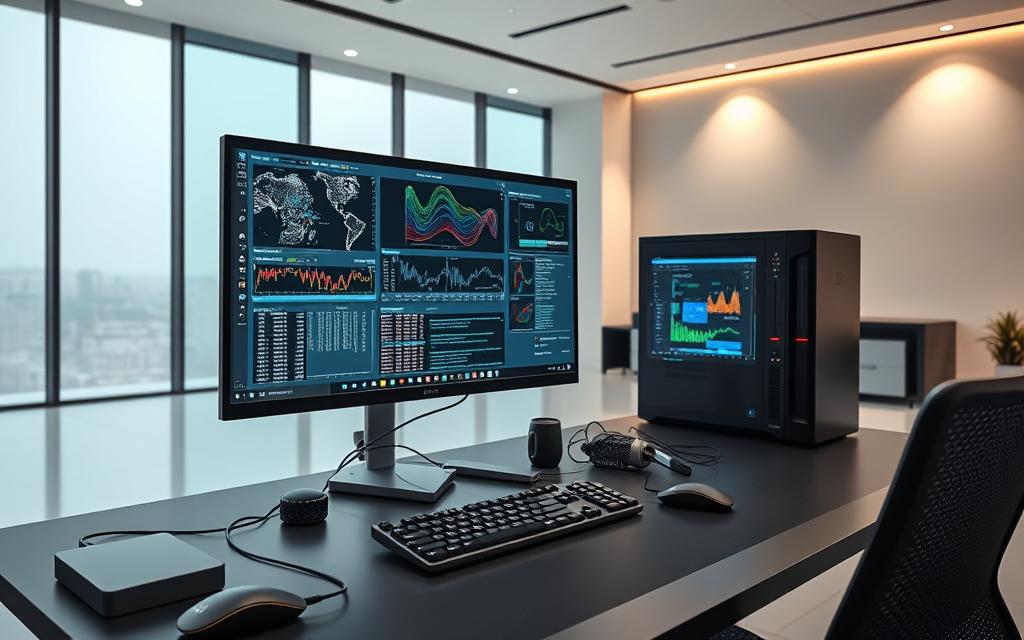
The Nmap tool is top for network scanning and security checks. It finds devices and checks open ports.
Nmap gives detailed port info and service details. Security teams use it to check firewalls and find vulnerabilities.
Tools like Advanced Port Scanner and Angry IP Scanner are also useful. They have easy-to-use interfaces for port analysis on many devices.
To really get network port basics, experts should know both command-line and graphical tools. This skill is vital for keeping networks safe and running smoothly.
Conclusion
Port numbers are key in network communications. They help different applications use the same network interface. This computer port overview shows how they work with IP addresses to guide traffic to the right services.
Port numbers are vital for network setup, security, and fixing issues. Knowing about well-known, registered, and dynamic ports helps IT experts improve network performance. It also keeps security strong.
This summary highlights the importance of knowing about port numbers. It’s a basic but critical skill for IT work. Understanding ports is essential for both simple connections and complex security setups. It’s a must-have in today’s networks.

